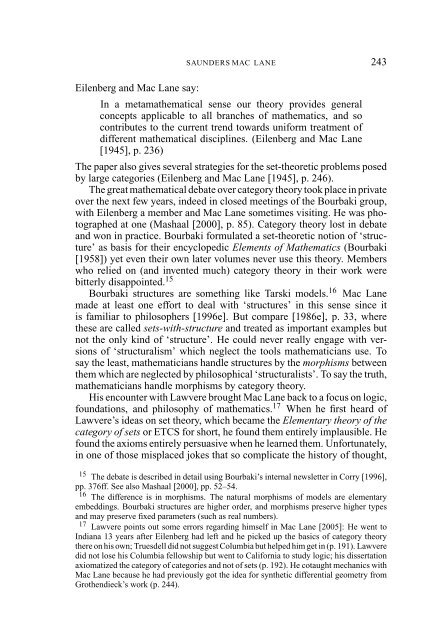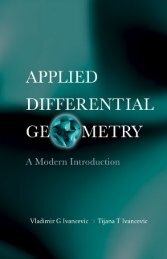PMeulogt MacLane
PMeulogt MacLane
PMeulogt MacLane
Create successful ePaper yourself
Turn your PDF publications into a flip-book with our unique Google optimized e-Paper software.
SAUNDERS MAC LANE 243<br />
Eilenberg and Mac Lane say:<br />
In a metamathematical sense our theory provides general<br />
concepts applicable to all branches of mathematics, and so<br />
contributes to the current trend towards uniform treatment of<br />
different mathematical disciplines. (Eilenberg and Mac Lane<br />
[1945], p. 236)<br />
The paper also gives several strategies for the set-theoretic problems posed<br />
by large categories (Eilenberg and Mac Lane [1945], p. 246).<br />
The great mathematical debate over category theory took place in private<br />
over the next few years, indeed in closed meetings of the Bourbaki group,<br />
with Eilenberg a member and Mac Lane sometimes visiting. He was photographed<br />
at one (Mashaal [2000], p. 85). Category theory lost in debate<br />
and won in practice. Bourbaki formulated a set-theoretic notion of ‘structure’<br />
as basis for their encyclopedic Elements of Mathematics (Bourbaki<br />
[1958]) yet even their own later volumes never use this theory. Members<br />
who relied on (and invented much) category theory in their work were<br />
bitterly disappointed. 15<br />
Bourbaki structures are something like Tarski models. 16 Mac Lane<br />
made at least one effort to deal with ‘structures’ in this sense since it<br />
is familiar to philosophers [1996e]. But compare [1986e], p. 33, where<br />
these are called sets-with-structure and treated as important examples but<br />
not the only kind of ‘structure’. He could never really engage with versions<br />
of ‘structuralism’ which neglect the tools mathematicians use. To<br />
say the least, mathematicians handle structures by the morphisms between<br />
them which are neglected by philosophical ‘structuralists’. To say the truth,<br />
mathematicians handle morphisms by category theory.<br />
His encounter with Lawvere brought Mac Lane back to a focus on logic,<br />
foundations, and philosophy of mathematics. 17 When he first heard of<br />
Lawvere’s ideas on set theory, which became the Elementary theory of the<br />
category of sets or ETCS for short, he found them entirely implausible. He<br />
found the axioms entirely persuasive when he learned them. Unfortunately,<br />
in one of those misplaced jokes that so complicate the history of thought,<br />
15 The debate is described in detail using Bourbaki’s internal newsletter in Corry [1996],<br />
pp. 376ff. See also Mashaal [2000], pp. 52–54.<br />
16 The difference is in morphisms. The natural morphisms of models are elementary<br />
embeddings. Bourbaki structures are higher order, and morphisms preserve higher types<br />
and may preserve fixed parameters (such as real numbers).<br />
17 Lawvere points out some errors regarding himself in Mac Lane [2005]: He went to<br />
Indiana 13 years after Eilenberg had left and he picked up the basics of category theory<br />
there on his own; Truesdell did not suggest Columbia but helped him get in (p. 191). Lawvere<br />
did not lose his Columbia fellowship but went to California to study logic; his dissertation<br />
axiomatized the category of categories and not of sets (p. 192). He cotaught mechanics with<br />
Mac Lane because he had previously got the idea for synthetic differential geometry from<br />
Grothendieck’s work (p. 244).














